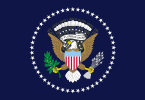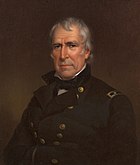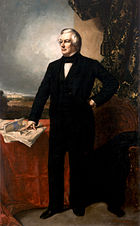Millard Fillmore
Millard Fillmore | |
|---|---|
 Colorized Restored Portrait of Millard Fillmore in 2021, the original Portrait is in black and white and was taken by Mathew Brady in 1851 | |
| 13th President of the United States | |
| In office July 9, 1850 – March 4, 1853 | |
| Vice President | None |
| Preceded by | Zachary Taylor |
| Succeeded by | Franklin Pierce |
| 12th Vice President of the United States | |
| In office March 4, 1849 – July 9, 1850 | |
| President | Zachary Taylor |
| Preceded by | George M. Dallas |
| Succeeded by | William R. King |
| 14th Comptroller of New York | |
| In office January 1, 1848 – February 20, 1849 | |
| Governor | John Young Hamilton Fish |
| Preceded by | Azariah Flagg |
| Succeeded by | Washington Hunt |
| Member of the U.S. House of Representatives from New York's 32nd district | |
| In office March 4, 1837 – March 3, 1843 | |
| Preceded by | Thomas Love |
| Succeeded by | William Moseley |
| In office March 4, 1833 – March 3, 1835 | |
| Preceded by | Constituency established |
| Succeeded by | Thomas Love |
| Personal details | |
| Born | January 7, 1800 Summerhill, New York |
| Died | March 8, 1874 (aged 74) Buffalo, New York |
| Nationality | American |
| Political party | Whig |
| Spouse(s) | Abigail Powers Fillmore (1st wife) Mrs. Caroline Carmichael McIntosh (2nd wife) |
| Religion | Unitarianism |
Millard Fillmore (January 7, 1800 – March 8, 1874) was the 13th president of the United States. He was president from 1850 to 1853. He was the last Whig president, and the last president who was not a Democrat or Republican.
Fillmore became president in 1850, when the previous president, Zachary Taylor died. The Whig party did not pick him to run for president in 1852. He ran for president in 1856, for the American Party but lost.
Early life
[change | change source]Millard Fillmore grew up in a poor family.[1] He worked hard to do well in school, and went to college. He got a job as a lawyer in 1823. In 1828, he was voted to be part of the New York congress, and made friends in the Whig Party. This helped him get chosen to run for vice president in 1848.
Presidency
[change | change source]When he was vice president, Millard Fillmore was in charge of the United States Senate while it was fighting over a decision about slavery involving Texas and New Mexico.
When he became president, the slavery issue was very intense (to the point where the southern states were close to choosing to not be a part of the United States anymore).
Fillmore signed the Compromise of 1850 (five laws which would calm down the slavery issue by pleasing both the northern states and the southern states). Although the Compromise of 1850 made the northern states and the southern states get along, the peace did not last forever. In the late 1850s, the north and the south stopped getting along.
California was made a part of the U.S. on September 9, 1850. It became the 31st state.
His decision to sign the Compromise of 1850, made many of the people in his Whig Party upset at him. They stopped him from running for president in 1852.
He started the first library at the White House.[2]
After being president
[change | change source]This section does not have any sources. (December 2020) |
After Fillmore, Franklin Pierce became the 14th president. Fillmore got a job in charge of the University of Buffalo. Fillmore joined the Know-Nothing Party and tried to run for president again, but the Know Nothing Party was not very successful. He died in Buffalo New York of a stroke at age 74.
There is a statue of Millard Fillmore at City Hall in Buffalo, New York.
References
[change | change source]- ↑ "American President: Millard Fillmore". Archived from the original on 2008-04-20. Retrieved 2012-12-28.
- ↑ "Fillmore's Foundation". loc.gov. Retrieved November 4, 2013.
Other websites
[change | change source]- Presidents of the United States
- 1800 births
- 1874 deaths
- Deaths from cerebral hemorrhage
- Millard Fillmore
- United States representatives from New York (state)
- Lawyers from New York (state)
- Deaths from cerebral infarction
- Deaths from stroke
- Politicians from Buffalo, New York
- Unitarians
- Whig Party (United States) politicians
- 19th-century American politicians
- American mayors
- Vice presidents of the United States




